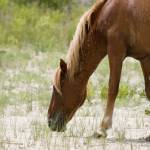Psyllium, Prebiotic, Probiotic Mixture: Does Sand Stand A Chance Against It?

Accumulation of sand within the intestinal tract of horses impairs digestive function, frequently predisposing horses to displacement of the colon and impaction colic. Other clinical signs that point to intestinal sand collection include chronic diarrhea and weight loss.
“Horses ingest sand inadvertently as they graze, especially if the ground is saturated by rain and roots are pulled up with the plant and eaten. Larger quantities of sand may be consumed if horses are fed in sandy lots or spend considerable time foraging in those lots,” explained Catherine Whitehouse, M.S., a nutrition advisor with Kentucky Equine Research.
Psyllium, the seed of the fleawort plant that swells and becomes gelatinous when moist, has shown some effectiveness in preventing and clearing sand accumulation in horses. Though most often fed alone, psyllium has been administered satisfactorily with magnesium sulfate.* In a more recent study, researchers tested the sand-clearing capability of a mixture of psyllium, prebiotics, and probiotics.+
Ten horses were used in the study. All were found to have sand accumulations based on auscultation and abdominal radiographs. To be included in the study, horses had to show at least 3 cm of sand buildup in the colon. Horses were divided into two groups, treatment and control. The treatment group was fed a supplement containing psyllium, prebiotics, and probiotics for 35 days. Fecal samples were collected from horses beginning 6 days before the start of supplementation and then every three days afterward. Of note, not all 10 horses were managed the same, as eight were allowed pasture access midway through the treatment, starting at one hour each day at the two-week mark and gradually extending to four hours daily by the conclusion of the collection period (day 35).
Fecal sand content was assessed in both treatment and control groups by way of sand sedimentation testing. Radiographs were retaken at the end of the treatment period.
The researchers found a significant reduction in sand accumulation in both treatment and control groups based on fecal sand sedimentation and radiography, but no differences were noted between the groups. This result was unexpected, and researchers theorized that pasture access might have influenced the results.
Managing horses in areas that have sandy soils is challenging, though certain strategies can be put into place to avoid ingestion of sand. Being especially mindful of how forage and concentrates are fed is essential. All feedstuffs should be offered in such a way that horses do not have to make contact with the ground. Use of deep buckets or feeders to discourage flinging feed, as well as rubber mats beneath feeders and troughs, can keep horses from eating sand or soil.
*Niinisto, K.E., M.O. Ruohoniemi, F. Freccero, and M.R. Raekallio. 2018. Investigation of the treatment of sand accumulation in the equine large colon with psyllium and magnesium sulphate. Veterinary Journal 238:22-26.
+Hassel, D.M., T. Curley, and E.L. Hoagland. 2020. Evaluation of fecal sand clearance in horses with naturally acquired colonic sand accumulation with a product containing probiotics, prebiotics, and psyllium. Journal of Equine Veterinary Science 90:102970.








